#a naturalist's opinion
Explore tagged Tumblr posts
Text
and when the morning breaks i will be lying in the riverbed dreaming of the way it was back then i sent them all away with bitter words i wish i’d never said and nothing green will grow for me again
#the naturalist#coyote wall#bandcamp#bandcamp friday#the naturalist (coyote wall)#LOVE THIS SONG#tunes#ari opinion hour#these arent even my fav lines ngl#Bandcamp
13 notes
·
View notes
Text
#YEAH #this was their way of telling the story they wanted!! (via @a-couple-of-dumbasses)
"Show us, not tell us."
~Supernatural Then and Now podcast. BONUS CLIP: Ben Edlund Talks
They couldn't TELL US. So they kept SHOWING US. Over and over and over again.
Dean and Cas loved each other. They were IN LOVE. BOTH OF THEM. Dean was never allowed to "tell us" but he "showed us" constantly.

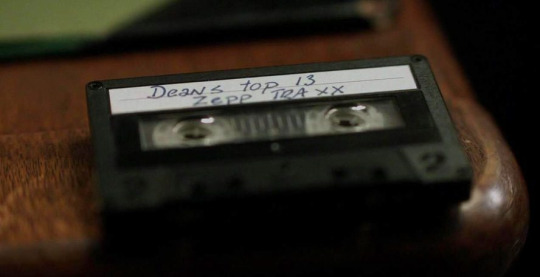




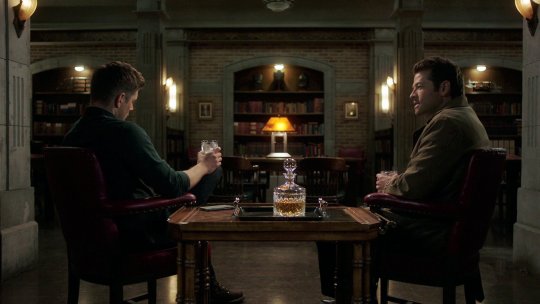
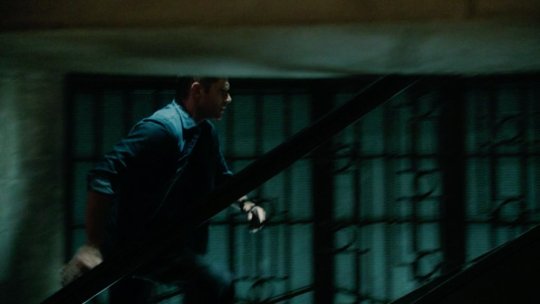
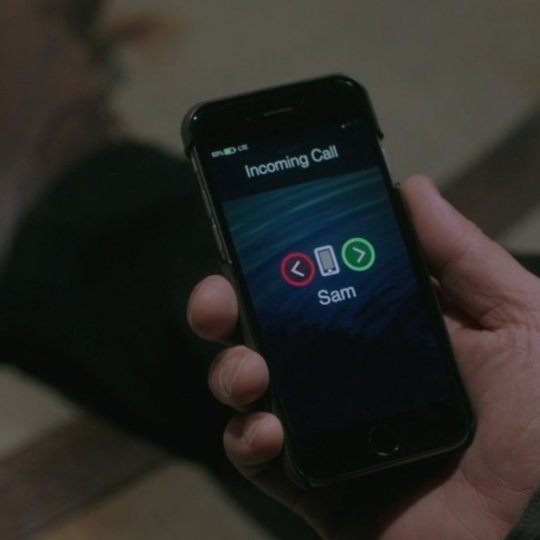


"Ok, we know what the subtext is, bury is a little bit"
I'M GONNA THROW UP
#I just kept asking when the writers can talk about this openly - I guess he just showed us how openly they can at this time?#and as I been saying - this series' triumph of show don't tell in this relationship makes it more naturalistic and compelling than most rep#and massively unpopular opinion but I don't ever want to trade that for visibility. we get both or we riot (against corporate ofc)#(because I could give a fuck if something ''convinces your homophobic uncle'' but if creators *can't* speak/write openly? riot riot riot)#spn writers#ben edlund#network fuckery#spn scripts#5.04
2K notes
·
View notes
Text
Let it be observed how naturalists differ in the rank which they assign to the many representative forms in Europe and North America.
"On the Origin of Species by Means of Natural Selection, or the Preservation of Favoured Races in the Struggle for Life" - Charles Darwin
#book quote#the origin of species#charles darwin#nonfiction#observation#naturalist#difference of opinion#europe#north america
1 note
·
View note
Note
For the Reverse Unpopular Opinion meme, Lamarckism!
(This is an excellent ask.)
Lamarck got done a bit dirty by the textbooks, as one so often is. He's billed as the guy who articulated an evolutionary theory of inherited characteristics, inevitably set up as an opponent made of straw for Darwin to knock down. The example I recall my own teachers using in grade school was the idea that a giraffe would strain to reach the highest branches of a tree, and as a result, its offspring would be born with slightly longer necks. Ha-ha-ha, isn't-that-silly, isn't natural selection so much more sensible?
But the thing is, this wasn't his idea, not even close. People have been running with ideas like that since antiquity at least. What Lamarck did was to systematize that claim, in the context of a wider and much more interesting theory.
Lamarck was born in to an era where natural philosophy was slowly giving way to Baconian science in the modern sense- that strange, eighteenth century, the one caught in an uneasy tension between Newton the alchemist and Darwin the naturalist. This is the century of Ben Franklin and his key and his kite, and the awed discovery that this "electricity" business was somehow involved in living organisms- the discovery that paved the way for Shelley's Frankenstein. This was the era when alchemy was fighting its last desperate battles with chemistry, when the division between 'organic' and 'inorganic' chemistry was fundamental- the first synthesis of organic molecules in the laboratory wouldn't occur until 1828, the year before Lamarck's death. We do not have atoms, not yet. Mendel and genetics are still more than a century away; we won't even have cells for another half-century or more.
Lamarck stepped in to that strange moment. I don't think he was a bold revolutionary, really, or had much interest in being one. He was profoundly interested in the structure and relationships between species, and when we're not using him as a punching bag in grade schools, some people manage to remember that he was a banging good taxonomist, and made real progress in the classification of invertebrates. He started life believing in the total immutability of species, but later was convinced that evolution really was occurring- not because somebody taught him in the classroom, or because it was the accepted wisdom of the time, but through deep, continued exposure to nature itself. He was convinced by the evidence of his senses.
(Mostly snails.)
His problem was complexity. When he'd been working as a botanist, he had this neat little idea to order organisms by complexity, starting with the grubbiest, saddest little seaweed or fern, up through lovely flowering plants. This was not an evolutionary theory, just an organizing structure; essentially, just a sort of museum display. But when he was asked to do the same thing with invertebrates, he realized rather quickly that this task had problems. A linear sorting from simple to complex seemed embarrassingly artificial, because it elided too many different kinds of complexity, and ignored obvious similarities and shared characteristics.
When he went back to the drawing board, he found better organizing schema; you'd recognize them today. There were hierarchies, nested identities. Simple forms with only basic, shared anatomical patterns, each functioning as a sort of superset implying more complex groups within it, defined additively by the addition of new organs or structures in the body. He'd made a taxonomic tree.
Even more shockingly, he realized something deep and true in what he was looking at: this wasn't just an abstract mapping of invertebrates to a conceptual diagram of their structures. This was a map in time. Complexities in invertebrates- in all organisms!- must have been accumulating in simpler forms, such that the most complicated organisms were also the youngest.
This is the essential revolution of Lamarckian evolution, not the inherited characteristics thing. His theory, in its full accounting, is actually quite elaborate. Summarized slightly less badly than it is in your grade school classroom (though still pretty badly, I'm by no means an expert on this stuff), it looks something like this:
As we all know, animals and plants are sometimes generated ex nihilo in different places, like maggots spontaneously appearing in middens. However, the spontaneous generation of life is much weaker than we have supposed; it can only result in the most basic, simple organisms (e.g. polyps). All the dizzying complexity we see in the world around us must have happened iteratively, in a sequence over time that operated on inheritance between one organism and its descendants.
As we all know, living things are dynamic in relation to inorganic matter, and this vital power includes an occasional tendency to gain in complexity. However, this tendency is not a spiritual or supernatural effect; it's a function of natural, material processes working over time. Probably this has something to do with fluids such as 'heat' and 'electricity' which are known to concentrate in living tissues. When features appear spontaneously in an organism, that should be understood as an intrinsic propensity of the organism itself, rather than being caused by the environment or by a divine entity. There is a specific, definite, and historically contingent pattern in which new features can appear in existing organisms.
As we all know, using different tissue groups more causes them to be expressed more in your descendants, and disuse weakens them in the same way. However, this is not a major feature in the development of new organic complexity, since it could only move 'laterally' on the complexity ladder and will never create new organs or tissue groups. At most, you might see lineages move from ape-like to human-like or vice versa, or between different types of birds or something; it's an adaptive tendency that helps organisms thrive in different environments. In species will less sophisticated neural systems, this will be even less flexible, because they can't supplement it with willpower the way that complex vertebrates can.
Lamarck isn't messing around here; this is a real, genuinely interesting model of the world. And what I think I'm prepared to argue here is that Lamarck's biggest errors aren't his. He has his own blind spots and mistakes, certainly. The focus on complexity is... fraught, at a minimum. But again and again, what really bites him in the ass is just his failure to break with his inherited assumptions enough. The parts of this that are actually Lamarckian, that is, are the ideas of Lamarck, are very clearly groping towards a recognizable kind of proto-evolutionary theory.
What makes Lamarck a punching bag in grade-school classes today is the same thing that made it interesting; it's that it was the best and most scientific explanation of biological complexity available at the time. It was the theory to beat, the one that had edged out all the other competitors and emerged as the most useful framework of the era. And precisely none of that complexity makes it in to our textbooks; they use "Lamarckianism" to refer to arguments made by freaking Aristotle, and which Lamarck himself accepted but de-emphasized as subordinate processes. What's even worse, Darwin didn't reject this mechanism either. Darwin was totally on board with the idea as a possible adaptive tendency; he just didn't particularly need it for his theory.
Lamarck had nothing. Not genetics, not chromosomes, not cells, not atomic theory. Geology was a hot new thing! Heat was a liquid! What Lamarck had was snails. And on the basis of snails, Lamarck deduced a profound theory of complexity emerging over time, of the biosphere as a(n al)chemical process rather than a divine pageant, of gradual adaptation punctuated by rapid innovation. That's incredible.
There's a lot of falsehood in the Lamarckian theory of evolution, and it never managed to entirely throw off the sloppy magical thinking of what came before. But his achievement was to approach biology and taxonomy with a profound scientific curiosity, and to improve and clarify our thinking about those subjects so dramatically that a theory of biology could finally, triumphantly, be proven wrong. Lamarck is falsifiable. That is a victory of the highest order.
2K notes
·
View notes
Text
1 of my da:v opinions is that. ok. “eldest daughter/people pleaser raised in a land strange to her people” is an awesome core character concept. it’s just not at all who i thought harding was based on her inquisition dialogue? in veilguard, harding talks abt how she learned to butter people up and take up less space after being harrassed as a little dwarven girl in ferelden; in da:i, she said the same experiences taught her to be rough-and-tumble and to aim for the balls. even her minstrel song is about the vindictive glee she feels in battle while “cutting men down to size.” it calls her the “inquisition’s bloody prize.” she’s a violent person! violent enough to inspire ballads! by fereldan standards!
it’s not that she couldn’t have learned both behavior patterns, but since we don’t rly see them contrasted in harding’s da:v characterization, it feels more like an overwrite to say she’s gentle now.
she’s also just never been a people pleaser! her role in da:i was straight talker! she was one of the few npcs the inquisitor could trust to give a blunt report on the terrain and political situation in a new map. in “jaws of hakkon,” she had the clearest, frankest, most compassionate but also harshest insight about how their personhood was being eclipsed by their reputation and titles—

she’s forthright, without illusions, and also one of the most uncompromised & uncompromising believers in the inquisition’s cause. NOT one of the many followers courting the inquisitor’s favor & backing for their own agenda. absolutely not a pushover or a kissass.
and what’s the significance of calling harding an “eldest daughter” with implied negativity when her ma doesn’t appear in the game and their relationship is drawn as wholly positive?
so i think maybe harding & taash could’ve switched roles, with harding being the clear eyes of the party who tends toward the blunt, crass, and fanatical but will never lie or fawn, and taash being the heart, the people-pleasing eldest first gen immigrant daughter who gets in touch with their masculinity, individuality and fire during the story—while still retaining harding’s warm, naturalistic speaking voice & taash’s clipped commentary, and the contrast between their personalities that attracts them to each other.
the addition of younger siblings, whose relationship with shathann is not strained in the same way taash’s is since they are neither adaari nor the children shathann left the qun for, could also add depth & complexity to taash’s questline, more cultural ties for them to untangle (or - my preference - to realize don’t need untangled) and another contrast with only child harding, whose heavy responsibilities are all taken on by choice and not inherited… or so she thinks until her own personal quest.
maybe taash could even have another mom, who isn’t fridged?
just a notion!
#dragon age#veilguard#taash#harding#dav spoilers#<- sorry! shouldve been in there for the taash/harding mention
294 notes
·
View notes
Text
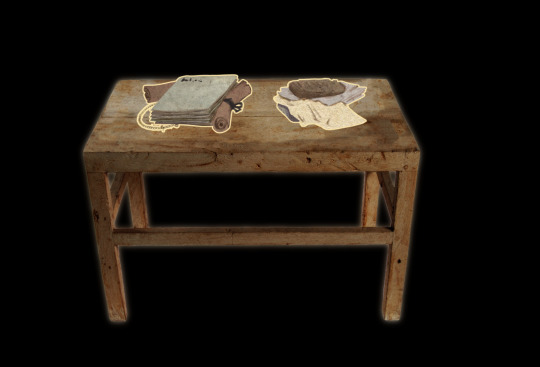
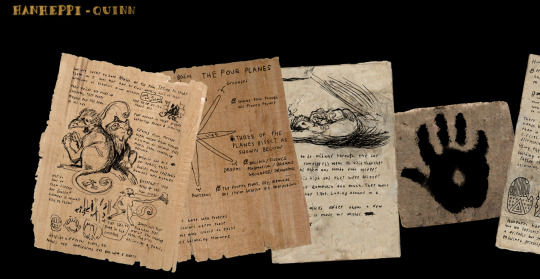
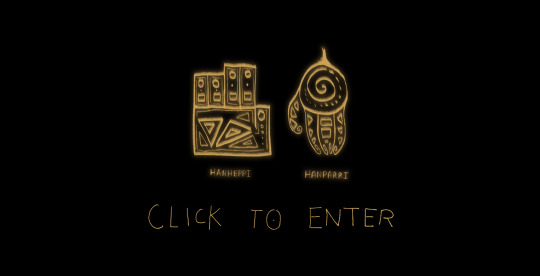

look at my webbed site you get to rifle through personal notes and doodles of a priest/naturalist and a highly opinionated butcher who wants to kill what is essentially the pope
#nnstuff#nnart#nnoc#hanheppi#hanparri#hondo#quinn#it doesn’t work on phonessss#original art#original character#oc art#website#website design
87 notes
·
View notes
Note
I think a thing that bothers me the most is how fragmented TG (the fandom) is now. After season one, many of us had issues with character writing, but it still felt like we were largely on the same page. Now, some people can accept Aegon got bad writing but not Aemond, Alicent, or Helaena. They are all “good” or “bad”characters depending on how much they hurt Aegon this season. I’m so glad he got the time to be well rounded, and that TGC delivered on all his scenes, but I think people forget Aegon has received some poor writing as well even this season. His whole outburst about Jaehaerys’s death is not about his son, but the impact on his legacy- I thought this very odd at the time, but realize it’s because they can’t have him mourn Jaehaerys for a long time either. Nobody on TG is allowed to focus on this dead child, least of all his mother! Aegon goes out drinking with his friends next episode 😭 seemingly unconcerned. But somehow only Alicent and Aemond are called out for this, when it is a clear problem that Daemon is more affected by this loss than the greens. It feels like such an uphill battle to even discuss the faction and family anymore.
This is such a good point!
I know I am so contrarian about this rn, but I have had some issues in connecting with Aegon's grief scenes over Jaehaerys this season. And it's such an opinion I DON'T want to have, bc I'm fully on the Aegon/TGC bandwagon and I do think TGC is a competent actor.
But it's something about the general clownery of the framing, how everything is gloomy and dark but at the same time no one gives that much of a shit over Jaehaerys? It's very weird to describe. I know Olivia also shows Alicent crying and swallowing sobs and trying to conceal her grief, but, if you think about it, Alicent is just Kind Of Like That in a lot of her scenes anyway. Big doe wet eyes, filled with regret and unspoken emotions etc so that her acting similarly after B&C kind of doesn't hit as much?
And, in that context, having Aegon rage over this event is rendered kind of.....hammy and, honestly, comical. I'm reminded of the scene of the small council where everyone is somber and quiet and he kind of looks like he's pretending to cry. In other moments it's fine but there are frames where I can't take it seriously and it registers in my brain like a parody.
I realise how I sound right now, like I'm not satisfied with the subdued performances, but I'm not satisfied with the expansive ones either. IDK. I have a huge problem with the framing and direction this season, I think it's a huge impediment in making me enjoy the supposedly emotional scenes.
All of this to say that I agree, Aegon has also received some bad writing this season, especially him ALSO being kind of over Jaehaerys the next episode. But people tend to overlook it, because when you draw the line, the writing for him is still so much better than what he got in S1.
And, yes, this is why I can't really join the choir in blaming Alicent and Aemond for how they act with him, because it's not a naturalistic and organic progression, it's shoehorned in with little buildup or motivation and not even drawn to its natural conclusion. For example, Aemond should have been toast the minute Aegon woke up, because Prince Regent or not, Aegon is still the King and has the power to remove Aemond if he fears him. He doesn't have to justify himself in front of anyone, just give the order to arrest his brother and name someone else as regent, then just go back to sleep.
#ask#anon#hotd critical [characterisation]#we're all in the same boat of being fucked over by the writers here
90 notes
·
View notes
Note
you stated before that centaurs had geldings; what was their place in the culture? did their existence persist in ironwall? do they exist in the modern day?
yayyyy ironwall.. i need to get back on that horse and draw more stuff for it
gelding as a practice dates back to the pre-florian era but it was quite rare. sometimes it would be done as punishment against rival stallions, sometimes undertaken willingly for spiritual or gender confirmation reasons, the context varied with no true universal use case or belief about what kind of person would result although it was a generally accepted belief that a gelding did not threaten a stallion so wasn't considered in the herd hierarchy as one
in the early creation of Ironwall it wasn't really much of a thing either, it actually took a century or more for the key florian beliefs to become internalised within the population - suddenly it wasn't just "these strict christian standards are being imposed on us", it was "these are OUR strict christian standards and we find fulfilment in this". when the citizens took florian beliefs and ran with them, they attained a level of strict fanaticism which even florian himself could never have dreamed of.
gelding in ironwall was a part of a cultural push to 'tame' and quote unquote civilise stallions and to turn their minds to the acceptable life pursuits of obedience, hard work, humility, and self-denial. as such it was considered ideal for military service especially with the added bonus of reducing the number of hierarchy squabbles in a military unit. nearly all centaur knights in the renaissance period were geldings & particularly devout adherents to chivalry. the effect of the procedure on strength & muscle mass was considered an acceptable trade-off. it has to be said, however, that any behavioural changes beyond a reduction in sexual desire were most likely psychosomatic. (this was later acknowledged as fact by historians, to great backlash from the naturalist movement of the late 20th century who were strict believers of centaur gender bioessentialism and taught that unaltered stallions were basically rage monsters by nature but like that's a cool and good thing just accept it ok)
anyway by the georgian period it wasn't particularly in vogue anymore outside of limited contexts (members of the clergy, castrati, etc). opinions of florian-era fanaticism had changed and the new hot thing was fetishising ancient greece & rome instead of course, because these are georgians we're talking about and that's their bread and butter. the window for acceptable standards shifted towards stallions who were procreative within their groups, patriarchs. this aligns with the formation & growth of a Middle Class, but also with certain families of centaurs in Ironwall now having attained some generational wealth and power, and an incentive to cling onto it (and you can't pass the nice townhouse to your kids if you are infertile). the industrial era saw a concentration of labour demand in Ironwall and some fears that there would not be sufficient population growth to meet it, sooooo
it continued to be used as a punishment until the mid-20th century, particularly against stallions who were caught starting too many fights in public (they would be sent to workhouses, too, which was the answer to every social ill from the victorian era onwards), and also against adult homosexuals.
40 notes
·
View notes
Note
Hiya Penny! I just got done rewatching the Sonic Frontiers highlights on your channel and I'm curious: now that we're like a year out from your playthrough, you think your opinions on the game have changed at all?
Nope! I had a pretty solid grasp of what I appreciated about the game at the time as well as what I wanted it to improve on and all of those things kinda remain true save for the stuff that they ACTUALLY DID improve on in updates haha!
Still the best written dialogue in a mainline Sonic title in well over a decade, still goes through the effort to (arguably OVERzealous-ly) tie in the stories of previous titles in a way that I really appreciate as an acknowledgement of intent to take the franchise more seriously, and ultimately I think it's still an incredibly fun game in spite of its jank and baffling design choices, of which there are admittedly very many! I like the open zone collectathon-style gameplay loop a lot and would be happy to see this formula expanded and improved upon in future entries. Though I still hope for a larger presence of meaningful NPCs in populated locations connected more seamlessly in the future, and I hope they go in a more naturalistic direction with the level design since they assumedly won't have the cyberspace excuse to fall back on in the future with their floating rails and Literal Sky Boxes popping in from 5 feet away. Pretty much all of these things have been true from Day 1 and I still feel them strongly!
266 notes
·
View notes
Text
An example of novel that follows the literary realism tradition but is sometimes approached under romantic lens, and therefore distorted into something else entirely - maybe because of the (bad) movies adaptations? because of the marketing and the covers? I don’t know but I will link this no longer rebloggable post for you to check - is Lolita by Vladimir Nabokov.


I read Lolita when I was seventeen, felt deeply discomforted but I liked the book, understood what it was doing with its narrator, but I have to add, before reading Lolita, I had already read Flaubert (Sentimental Education, didn’t finish Madame Bovary) and Émile Zola to name a few. I think that growing up I have read more books in this genre than others? I don’t know considering that back then I had to read a lot classics for school.
But long story short, I think something similar maybe it’s occurring with Saezuru. To be clear, I am not saying that you have to read it in a certain way, please I don’t really want to even imply that. Read it for yourself and your pleasure first. What I am saying is that, like Lolita, to me Saezuru makes total sense if we assume that it is written with a realistic intention and therefore not exactly bound by the rules of romantic novels that tend to present more positive and idealized views. After all manga are divided into demographics more than their genre, so authors draw very different stories. I still want these characters to find happiness! But I also want to be able to buy the eventual resolution and therefore I appreciate that the development of the story feels organic.
Anyway just a thought. Nakobov himself wrote (in Strong Opinions):
Reality is a very subjective affair. I can only define it as a kind of gradual accumulation of information; and as specialization. If we take a lily, for instance, or any other kind of natural object, a lily is more real to a naturalist than it is to an ordinary person. But it is still more real to a botanist. And yet another stage of reality is reached with that botanist who is a specialist in lilies. You can get nearer and nearer, so to speak, to reality; but you never get near enough because reality is an infinite succession of steps, levels of perception, false bottoms, and hence unquenchable, unattainable. You can know more and more about one thing but you can never know everything about one thing: it’s hopeless. So that we live surrounded by more or less ghostly objects— that machine, there, for instance. It’s a complete ghost to me— I don’t understand a thing about it and, well, it’s a mystery to me, as much of a mystery as it would be to Lord Byron.
As for marketing, if you check the link and think about Saezuru: the covers and merchandise vs the content of the chapters, vs the story as it’s told, the parallel with Lolita makes sense to me. The cover only has one imperative: to sell. But once you are alone with the story, you see that stylistic choices, tone, everything suggest that you read it in a critical way.
The way Yoneda Kou draws is also quite sober, discarding decorative details and paying attention more to frame and pov. The way she presents what happens is objective and detached, neutral I’d say, making us impartial observers most of the time, letting the actions speak without commentary being made. The dialogue is hard for our translators because it recreates the speech patterns of the various characters faithfully. And these characters are common yakuza that live harsh realities, the gritty social aspect of it is visible and part of the story, as well as social injustices and personal trauma, and keen and realistic attention to human behavior.
I guess all this clued me in to reading the story the way I do, and probably also why I chose it in the first place. Realism is the genre of fiction I am more read in, although I am expanding my horizons more and more.
#saezuru tori wa habatakanai#eri reads saezuru#yoneda kou#sometimes discussions are posed to frame one character being more right or wrong in connection to the other but#that isn’t how human behavior works imo
29 notes
·
View notes
Note
Unpopular opinion: parts of the cr fandom are really dismissive/ reductive of Travis’s characters. It feels like it’s due to Travis being seen as THE cis het man of the group, and by extension his characters must be heteronormative and bad, despite the fact that you could have queer interpretations of his characters. At the very least, Travis’s characters explore masculinity and the different ways it might look. It’s like the people who are all “ew men are gross and shitty” and act like that’s an absolutely normal reaction to a man just existing.
So this is another one in that I agree with the initial statement, but I'm actually not sure re: the reasoning why. I think it's possible but I could not tell you for sure.
I used to, again, think this was people carrying through Campaign 1 elements well beyond the point where C1 had ended, and so Grog having an intelligence of 6 was being applied to Travis; and this definitely does come through to an extent when people treat Fjord (objectively as smart as Beau without her circlet) as stupid or act shocked that Chetney is the brains of Bells Hells or that he can play a Cerrit, Fjord, or Nathaniel. However, again, I think this is one of those opinions that pops up among people who weren't around for Campaign 1 (or early enough in C2 to be exposed to it regularly) so I don't know if that's the case anymore. It could still be - it could be that Approved Fandom Opinions get passed down even when the logic behind them has long since been lost; that's a really common thing in institutional memory. But I can't say for sure.
I also have in the past credited it to, as you said, people assuming his characters are the cishet guys and then writing them off. That's still possible - I've seen both Fjord and Chetney called "token straight" despite considerable evidence of bisexuality, and they also paradoxically are both commonly headcanoned as trans while still getting called "token straight," which sort of ties into a post I would need to find from someone else from quite some time ago about which cast members are granted agency by the fandom in their choices vs. which are assumed to be the victims of circumstance. And I do think that there are people in fandom who have decided men are icky or whatever, and I used to think this came from a place of bigotry and a slide towards t*rf ideology but I now do genuinely think it's just idiots who don't grant interiority to characters outside their own limited understanding.
But I think it's also useful to consider a few things, most of which I've brought up before:
Travis is extremely offline. He is not here to entertain your headcanons; he has been politely but openly dismissive of some (imo, really fucking dumb) fanon/fan theories. I think the cast frequently talks about how it's their table, and I think that's valid and correct, but Travis is one of the players who lives it the most. He is playing this game with his friends, and he'd like it to be a good story, but if you don't like it, he is not here to make you like it. I think that really fucks with the parasocial connections some people desire with the cast.
Travis's characters tend to examine masculinity as a performance but also the general performance of the self, and the fact that you cannot in the end control how you are perceived entirely, and I think that really unsettles people who have equated presentation with reality and are again, looking for external validation of the self.
Travis can play it big but he's often extremely subtle, especially with his more serious characters, and he's not as easily quotable out of context as some others at the table. I think because he is a lot more naturalistic than dramatic at times (Chetney notwithstanding) and isn't as pithy and quotable in his characters as many of Taliesin's PCs are, and a lot of the strength is in the delivery, he gets overlooked despite being very good with words on the fly.
And finally: this would be a whole post on its own but people are still very foolishly wed to this idea that pressing the big red button in D&D is Wild and Chaotic and haha Big ADHD Man when it's actually how you play D&D if you're not a coward; the button is where the story is stored, and a lot of Travis's strength is that he is extremely good at understanding what the GM wants and supporting it with sufficient grace that it's only visible if you know what you're fucking doing.
#answered#Anonymous#in the end although it's frustrating the fandom often sells him short#every gm is like this man is the greatest player i've ever had so who's really right in the end#anyway. watch candela chapter 2.#opinions rating ask meme
202 notes
·
View notes
Note
Would it be reasonable to use a mirative as a way to say that you "ended up doing X" like saying "I ended falling asleep" or "I'll end up getting sick"? I'm having a hard time confirming anything about how languages encode intention, or the lack thereof. After some thinking that's what I came up with, though, but I dunno if I'm just reachinga bit too much with that.
Sure? If it makes sense in your language.
I'm going to pull out a paragraph from the article on mirativity on Wikipedia that I believe helps to illustrate one of the central problems conlangers face in interacting with linguistic research:

As you can see, there's a back and forth here involving Aikhenvald (because of course) and the one who proposed the category of mirativity (DeLancey) and others. In my opinion, the entire argument is f*cking ridiculous and is best settled by asking, "Who tf cares?" It reminds me of the Wikipedia article on the hortative that has red flags at the top saying, if I may paraphrase, "Uhhh...wtf?"
In short, both linguists on either side of this argument believe there's a trophy shelf called GRAMMATICAL CATEGORIES where certain features may sit proudly with their name emblazoned on a plaque above the name of the linguist who discovered it. On the one side, you have DeLancey saying, "Mirativity deserves its own trophy with my name on it!" On the other side, "No, what you've discovered can be encoded with other grammatical strategies, therefore it doesn't deserve its own trophy, and you get your name on nothing!"
Meanwhile, languages do need to have a way to express things like "We ended up going to the slam dance protest after all" and "He's apparently really good at juggling mosquito hawk wings", so what does it matter if either of them get a trophy on the shelf or not?
For a conlanger, what matters is how your language is going to express these meanings. It is not the case that you have to unambiguously express every shade of meaning without resorting to complex explanations. If we could do that we wouldn't have fiction. Part of the trick with learning how to create a conlang that feels more natural (whether you're going for a naturalistic conlang or not) is that the majority of meaning are expressed with non-dedicated morphological constructions.
For example, if you look at everything as morphemes, then there should be a morpheme for everything. If you want to turn a statement like "John is giving a fish to the flower" into a question you simply take your question morpheme and stick it somewhere. But look at English!
STATEMENT: John is giving a fish to the flower.
QUESTION: Is John giving a fish to the flower?
No morpheme there at all but a little switcharoo with the word order. Some linguists and a lot of conlangers want to get all galaxy brained and say "MAYBE THE WORD ORDER CHANGE IS THE MORPHEME", and, indeed, maybe the real conlang is the friends we made along the way, but a better way to look at it is we use what we have to express new meanings before creating something new.
So, if your state zero is you have something that express mirativity (i.e. surprise at some state of affairs), then, hey, why wouldn't use that for "it ended up that"? It's kind of surprising if you end up doing something. It's running counter to your expectations. Sure! If you want to get all "my eyeglasses put on a pair of sunglasses" on it then you can have your genunine-shock-mirativity suffix and your we-didn't-intend-to-but-it-happened-anyway-mirativity suffix and someone-told-us-it-would-happen-but-we-didn't-believe-them-but-then-it-happened-but-we-weren't-dismayed-mirativity suffix, etc., etc. If you keep going down that road, though, you end up with there's a unique word for every possible thought, and you end up with an ultimately unlearnable and unusable language.
In short, you do you. As long as you can explain it and it makes sense to you, then it works.
50 notes
·
View notes
Text
Sonic the Hedgehog x Male! Fraud Magician Bunny Reader!
Summary: Sonic admires an “all-knowing oracle” whom everyone relies on for answers. Unbeknownst to him, said “all-knowing oracle” is a wimpy and insecure fraud. Also takes place in the Sonic X universe.
Warnings: None, just fluff c:
FEM READER DNI!!!
A/n; felt left out not seeing any sonic x male reader fics, so I decided to make my own! Supposed to be read as male reader but fuck it we ball.(May or may not be oc inspired lol)
~~~~~~~~~~~~~~~~~~~~~~~~
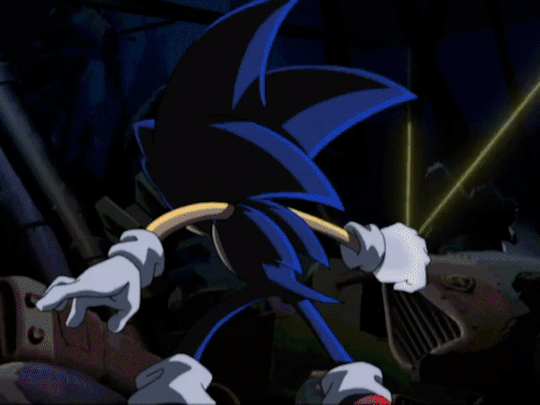
• Let’s get one thing straight, you never wanted to be someone everyone relied on for answers.
• But every time someone asks for advice you give them an answer and it always comes true out of convince! You promise!
• You were even popular because most would consider you handsome, your slicked back hair and magician persona made for a good eye catcher.
• Every time someone has a problem, you fix it. That’s who you were to the sonic crew!
• To sonic however, you were a pillar of some sorts.
• Sure you had more bark than bite but you proved yourself useful and caring of others, and sonic admired that!
• However, everything goes downhill when Dr. Eggman unleashed his newest robot that captures tails and cream.
• Though no one expected Dr. Eggman to throw everyone back in time to The Big Apple, everyone caught wind when you couldn’t predict Dr. Eggman releasing a newer and bigger bot that managed to catch Tails.
• Everyone you knew had become stressy not knowing what would happen next.
• Well, everyone except Sonic and co. (i.e; Tails, and Knuckles)
• Chaos knows they always have their guard up.
• But that was besides the point, point is, when everyone had been betrayed, lied to, and/or resented you (though not many) Sonic stuck around through and through.
• Everyone knows Sonic isn’t afraid of not knowing what will happen next.
• His unshakable confidence has the charming nerve to infect you to the core, and even changes you for the better.
• learning new spells and tricks, you have your own way of changing (though not many would bother to care after your unintentional scam, a win is a win in your book!)
• Now as for Sonic’s form of romance, let’s just say it isn’t as “romantic” as many (and myself) would like to admit.
• Sonic would actually be very nonchalant about your new-found relationship.
• Sonic is a naturalist at heart, so even if it’s a stretch, sonic loves to enjoy the sights (even if you aren’t there with him) but who knows! Maybe he might treat you to a nice coconut from green hills or even share a chili dog.
• An endearing trait of his I reckon is that he definitely teases you, though depending on which sonic, he might tease you more or less than the other characters (I.e; sonic boom sonic vs. Sonic movie sonic).
• However if we really are desperate for a certain blue-hedgehog’s affections, I think I’d be adorable if he had a thing for collecting various flowers from a shrub or something small-scale.
• Not only that but he’d be more than willing to take naps next to anywhere, on the beach, in a hammock, in a bush, but the strangest place you two were found was on top of a skyscraper in the middle of New York!
• Not to mention how soft your fur is, perfect cuddle material in his opinion! He also sometimes uses your overgrown ears as a blanket when it’s a bit chilly out.
• I’d like to think he also admires your latest magician skills, sure he’s not one for over-the-top romance but he’s gotta admit you’ve got a good grip on your flirt game for a guy so shakey.
• he wouldn’t reciprocate on your advances though. Or at least not in an obvious way.
• A few things he’d do to show (small) signs of affection is take note of places or things you like for a small trip or gift.
• Another thing he’d do is carry you bridal-style which might be a bit selfish on his end because he usually does this the most when you are in danger and need a quick pick-up compared to others where he just picks them up, throws them, and/or drags them.
• I don’t think he’d make a scene to others about you two being boyfriends either. Like if someone brings up a topic about relationships or whatnot, sure, he’d bring you up.
• Sure Amy would be disappointed but everyone else was mostly confused.
• To be fair, you two weren’t really seen as all that close. In fact, they rarely see you two together.
• The only times you two make any form of contact is when you need Sonic’s help with a villain, or when he shares a (few) snack(s) with you, or when you two are cuddling in an odd disclosed area and- ohhh.
• He isn’t flustered easily either, but one thing he goes absolutely weak for is the rare chance you make a grand gesture during a fight.
• Like if you had to make a risky distraction on the dime, sure Sonic wouldn’t be a blushing mess, but he’d be lying if he said he didn’t think you looked good jumping into action like that for him.
• But one thing he’d never admit is that he thinks your bunny traits are adorable, like when you scrunch up your nose when something makes you anxious, or even when you thump your foot when you get frustrated with something or someone. (It especially happens when he teases you, so he teases you even more)
• He may not be the most romantic boyfriend, but damn is it hard to be mad at him.
~~~~~~~~~~~~~~~~~~~~~~~~
A/n; thank you so much for reading this fanfic, it turned out way longer than I thought it would but it was so worth it! Reblogs and likes are greatly appreciated, and feel free to send a request for more fanfics (rules are in my bio, I only do gender-neutral and male reader requests)
#sonic the hedgehog#sonic x male reader#sonic maurice hedgehog#sonic#sonic boom#sonic movie#sonic movie 3#sth#sth headcanons#sth fandom#sth oc
24 notes
·
View notes
Text
Bestiaryposting Results: Miscellaneous Lizards
Slightly delayed, sorry. What happened there is I drafted it, looked at the time, thought I should give it a couple more hours to make sure everyone had time to post their stuff, and then... forgot to go back. Anyway.
Our second week of miscellany, where we have a bunch of the critters who didn't get their own entry grouped together. This one is the shortest, with just three lizards to look at.
If none of that made sense to you, you can find answers at https://maniculum.tumblr.com/bestiaryposting.
To see the entries for the three lizards in question, click here:
And to see next week's miscellany so you can participate, click here:
Without further ado -- and crossing our fingers that the tagging system is cooperating this time -- here are some lizards below the cut.
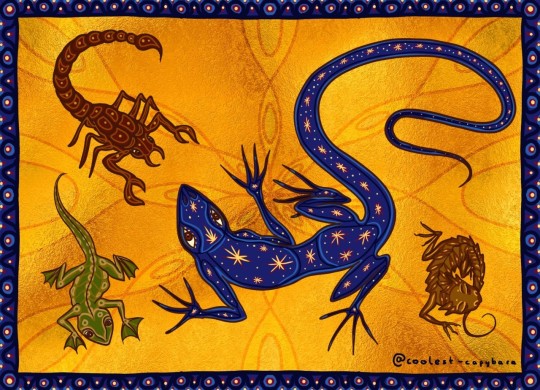
@coolest-capybara (link to post here) has drawn all three, along with a bonus... well, the post says it's a scorpion, but I thought those looked different... anyway. The smaller lizards are darling, and I think the celestial look of the Rukhgarukh came off really well here. (And thank you for providing alt text.)
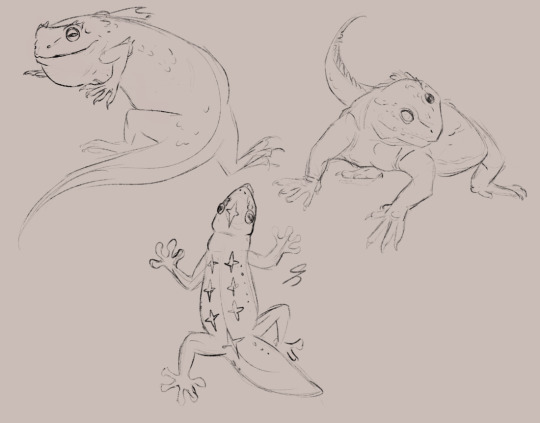
@silverhart-makes-art (link to post here) has done some quality pencil sketches that also led me to learn cool things about the tuatara. I think the Nglushogog turned out particularly well here; the draconic vibe is interesting.
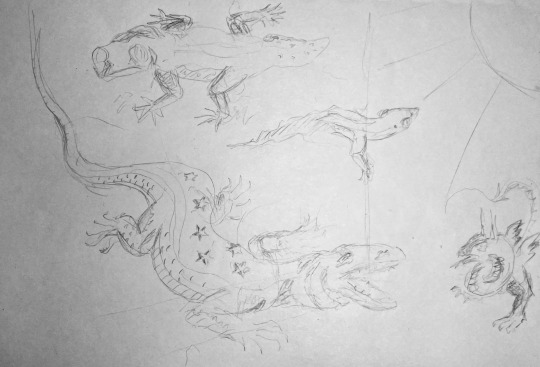
@cheapsweets (link to post here) has done a pencil sketch of the three -- I like the Nglushogog again here. The whole "lizard with the face of a frog" thing is honestly turning out more interesting than I expected. And hey -- in the bottom right -- what is that? Looks a bit like a scorpion to me.

@strixcattus (link to post here) has drawn some interestingly varied lizards, and included some nice lettering for us. I think this is the first one where the Hrutdearya really stands out to me -- it just looks so small & cute. As always, I recommend reading the linked post for Strixcattus's work, as she writes naturalistic descriptions to go with the illustrations -- I think the one for the Nglushogog is clever, and also hits pretty close to the mark in one particular way... we'll get to that.
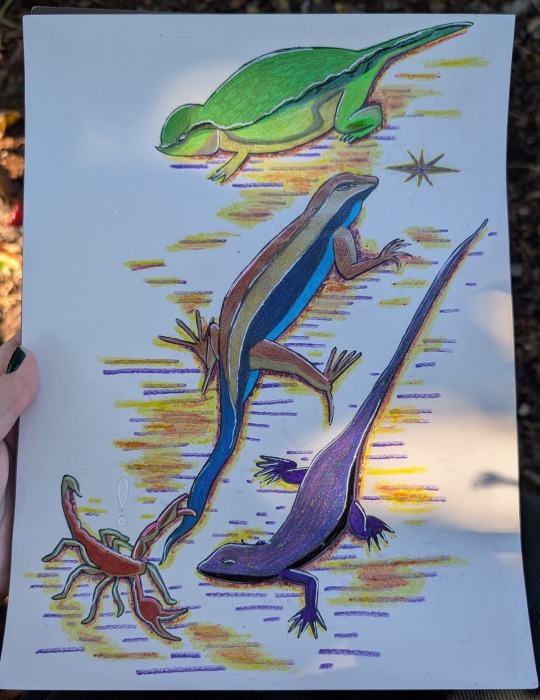
@wendievergreen (link to post here) has drawn some very realistic-looking lizards by doing mashups between various Oregonian species. All extremely solid, in my opinion; I especially like the coloring on the Rukhgarukh. Also the exclamation point over the "scorpion" is a nice touch. More details in the linked post (and thank you for providing alt text).
So! Aberdeen bestiary.

This is actually just the illustration for Lizard. Which... I guess? Come on, monks, surely you've seen a lizard, what are you doing here? Why does it have that face?
Nglushogog
The Nglushogog gets no illustration of its own -- that single sentence describing it occurs in the intro to the brief "lizards" section. However, I can tell you that it is the botruca or botrax. (The entry uses both -- it mentions the "botrax" in a list of lizards at the start, then notes that the "botruca" is called that because it has a face like a frog.) This is not particularly helpful, however, because that is not a real lizard. The Medieval Bestiary website provides a little more information on it at this link here, and suggests that this was actually originally just the entry for a frog (or toad). This theory is supported by the fact that, according to the Aberdeen Bestiary, it is named after the Greek word for "frog". Which... close enough; Wiktionary tells me that Ancient Greek* for "frog" is batrakhos, and that seems plausible to me because we have the English word batrachian. (Even though Tumblr thinks we don't and has red-underlined it.) So probably somehow** "frog" turned into "frog-like lizard that has the same name as a frog".
*I'm specifically using the Ancient Greek forms here because I'm pretty sure those are the ones our authors would be most familiar with unless they happened to be writing from the Eastern Mediterranean.
** Looks like it might have been Isidore of Seville's fault, which... shocker. Or at least, he's the earliest source bestiary.ca has listed for that entry, and we know that he's where the Aberdeen Bestiary gets its etymological trivia, so it seems likely that he did that.
Hrutdearya

This is a very interestingly-stylized interpretation of "looking through a crack in a wall". Who built that little archway, and does it actually help with the sun-gazing?
Anyhow, this is the saura, which... well, I can't say it's not a real lizard, but it's also clearly the result of a misunderstanding. As we all know from (I assume) reading about dinosaurs, saura is just Ancient Greek for "lizard". So probably this was originally supposed to describe something all lizards do, and this bestiary turned it into a specific type of lizard.
Rukhgarukh

This one, as you can tell by it looking absolutely nothing like it, is a newt. It has stars on it because the Latin for "newt" is apparently stellio. It's possible that the artist did not realize it was supposed to be a newt. It's possible it wasn't supposed to be a newt originally, but I don't have time to look into that right now.
Anyway, that's lizards. Tune in next week for some snakes, a category to which the above legless critter apparently does not belong.
#maniculum bestiaryposting#miscellaneous lizards#maniculum miscellaneouslizards#nglushogog#rukhgarukh#hrutdearya
31 notes
·
View notes
Text
Of the Monstrous Pictures of Whales
In my very informed opinion it is absolutely essential to read Chapter 55 with visual aids. Here are some highlights pulled from Ishmael's Most Hated depictions so we can all be on the same page about what whales definitely don't look like.
Guido Reni & William Hogarth get the benefit of the doubt on account of the fact that it never says Perseus's sea monster is a whale. We can all agree that these definitely are not:


2. Robert Sibbald was the first naturalist to officially describe a blue whale and I'll give him a pass on being first and blue whales being incomprehnsibly large even now, but this really is not accurate in pretty much any way.
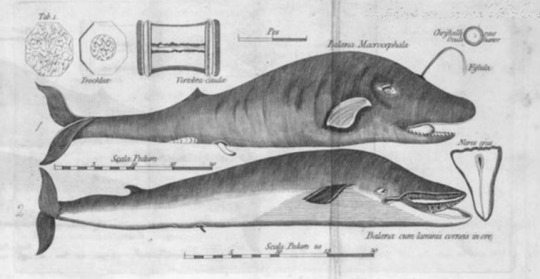
See below the cut for more "monstrous" depictions!
3. Physeter or Spermaceti Whale by Captain Colnett. Allegedly drawn from "life" but, getting out our scale rule will show that its eye is the size "a bow-window some five feet long. Ah, my gallant captain, why did ye not give us Jonah looking out of that eye!" Truly a missed opportunity from the captain there.


4. Oliver Goldsmith's An History of the Earth and Animated Nature is truly a treasure. Per Ishmael "I do not wish to seem inelegant, but this unsightly whale looks much like an amputated sow". The illustration on the right isn't directly mentioned in here but honestly it's a treasure and I feel obliged to share it with you. There's too much going on there for me to possibly pick out highlights. They're so bad they're perfect. No notes.

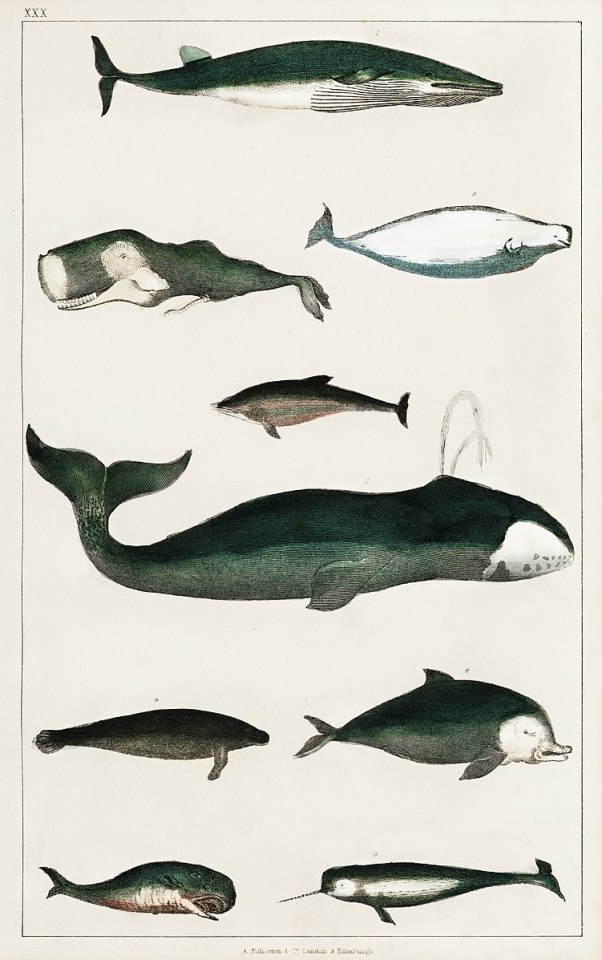
5. Bernard Germain, defying the laws of physics here. "Not only incorrect" but also does "not to have its counterpart in nature"
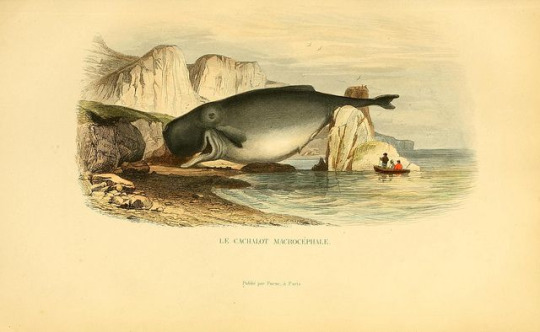
6. Cuvier's Sperm whale is "not a sperm whale but a squash." Succinct and shady. Perhaps my favorite description in the entire chapter.
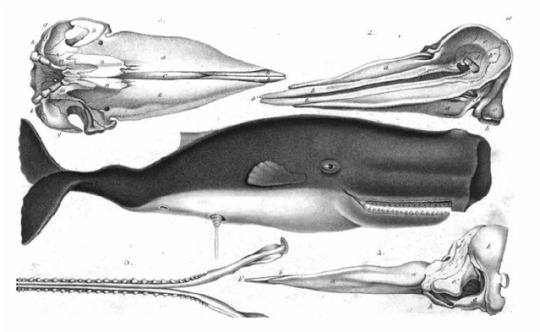
#whale weekly#moby-dick#yes i did prep this in advance#yes i regularly think about the phrase “not a sperm whale but a squash”#why i've latched onto that one i couldn't tell you#moby dick
309 notes
·
View notes
Text
There is a vital part of Fallen London that the railway has recently given me a new lease on, so I'd like to talk about it for a bit. The topic in question is the colours of the chessboard: White, Black and Red.
In their purest form, these categories are the sides of the Great Game. White represents light, law and order, but also hierarchy and restriction. Black represents darkness, freedom and equality, but also chaos and uncertainty. Red represents... neither of those.
In the context of the Great Game, Red is typically just in it for itself, ideologically neutral. Many of the branches which require having a specific colour on the chessboard require White/Red or Black/Red – while the monochrome pair are doing the act because they believe in it, Red is just doing it as a means to an end.
The Great Game isn't the only place this trichotomy exists in Fallen London, though. Many choices can be linked back towards the trio:
Identified with a School is one of the most obvious: the light-loving Celestials, the avant-garde Nocturnals and the explicitly venal Bazaarines.
The sides of the Parabolan War: the Cats, the Fingerkings and the Chessboard.
The Youthful Naturalist's qualities (and their associated endings): Acceptance, Cunning and Malleability.
Even the BDR stats are loosely aligned: Respectable, Dreaded and Bizarre.
But the triplet that has fascinated me recently is that of the factions of the Tracklayer's Union: the Prehistoricists, the Liberationists and the Emancipationists. All three factions are revolutionarily-minded, but their diversity brings a lot more texture and depth to the dynamite faction than the exclusively liberation-focused view we've had previously. While this is definitely a good thing, and has helped me figure out more diverse opinions on the revolution for my characters, the thing I want to focus on is Emancipationism.
Similarly to many of the incarnations of the trichotomy, Red is a bit of an outlier. The Prehistoricist utopia is a perfected system which serves those it governs; the Liberationist utopia is one without a system at all.
The Emancipationist utopia is everyone getting fed.
This placement of Red as a sympathetic side, and a creator of current good, is very refreshing. The writing itself admires that thought, too. In a balanced city, while the other two factions plan for the future, the Emancipationists are doing tangible good in the here and now: making sure everyone survives to realise their grand plans. It keeps the fundamental core of red, its apartness from the ideological battle, and turns it to something kind. Red is not just the dilettantes playing the chessboard for profit (though it is, still, them,) but it is also those agents trying to do good, no matter which side it happens to serve. It is the artists who pursue beauty in whatever style strikes them in the moment. It is those who war for the sake of peace.
83 notes
·
View notes